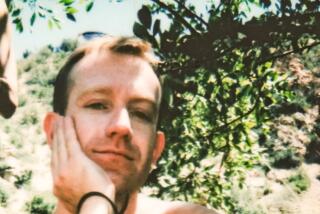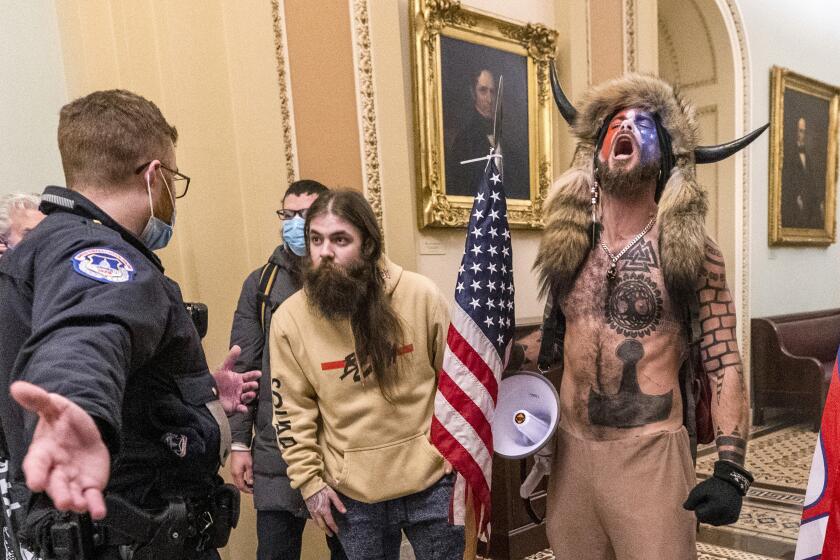The Politics of Hysteria
At the height of the Cold War during the Eisenhower administration, historian John Hope Franklin wrote a public letter wondering why the White House had a portrait of the person who had come the closest to overthrowing the government by force and violence. The image of Confederate Gen. Robert E. Lee was soon removed.
No member of the Communist Party, USA, ever repeated Lee’s attempt. Even so the federal government attacked the party’s leadership for conspiring to advocate such an overthrow, an approach that punished speech twice removed from criminal behavior. Such measures were unnecessary considering the legions of informers in the party, and in defense plants, ethnic communities, labor unions and reform organizations who surely would have provided the intelligence for the government to squash any such illegal manifestations at their inception. Neither the internal nor national security of the United States was under threat. What, then, was going on?
“Many Are the Crimes” provides an answer. Challenging cliches about McCarthyism, Ellen Schrecker describes a conspiracy that Sen. Joseph McCarthy neither initiated nor dominated. He was an extremist blip on the antidemocratic radar whose indecency only reflected the larger, more sinister forces at work. If the national memory is ever to reach closure on this tragic episode, Schrecker’s analysis is a significant and compelling contribution.
But closure may be impossible. As recent reactions to historical revisionism--like the controversy over the Smithsonian’s Enola Gay exhibit--suggest, patriotic mythologies do not die; they do not even fade away. The symbol of “tale-gunner Joe,” McCarthy’s persona in World War II, nurtures a fantasy that personalizes a vast crusade, finds his downfall to be symptomatic of the system’s essential health and characterizes the crisis as a cyclical aberration without structural consequences. Schrecker’s evidence demands we get beyond that simplistic understanding.
One of the major visuals at the televised hearings about subversion was the web chart of interlocking conspirators, often with a Kremlin center. “Many Are the Crimes” creates a new web chart--of anticommunist enemies with J. Edgar Hoover and the FBI at its center. It is an imposing edifice, indicative of a diverse, leagued collaboration. The genius of Schrecker’s study lies in its panorama of the complicity that developed in the witch hunt, uniting ex-Communists, left sectarian union elements, the Catholic hierarchy, Socialists, professional anticommunists, the American Legion, congressional investigators, labor leaders, the Hearst newspapers and, eventually, liberals and the American Civil Liberties Union. “It was the very diversity of the anticommunist network,” the author argues, “that made it so powerful.” That network’s drumbeat of propaganda demonizing Communism steadily entered the political center until it had succeeded in “teaching American liberals how to think about Communism.”
If the diversity of the anticommunists gave their movement strength and legitimacy, the diversity of their victims never protected them. Schrecker’s chapter on the CPUSA is entitled “We Were Sitting Ducks.” Indeed. Only one of many strands in the party’s policies and practices came to stand for the totality of them: namely, the secret, disciplined, Soviet-controlled cadres. But there was also a vital and vigorous movement that fought for racial integration and equality, played a major role in organizing industrial unions, sponsored reform associations “for any taste” and provided insurance for thousands of ethnic workers. In Schrecker’s view, however, the party’s reputation and integrity had been so seriously compromised by its Soviet relationships that “[t]here could have been no McCarthyism without the American Communist party.” Nor were future victims of repression randomly selected but rather singled out as people “in or near the American Communist party.” The author argues that the CP played a major role in its own victimization, yet her narrative often refutes that hypothesis. The party survived the witch hunt, while thousands of other Americans became the sacrificial proxies that seemed to certify the enormity of the ideological threat.
“Many Are the Crimes” provides a brilliant, tenacious, massively researched exploration of that sacrifice. Schrecker does not claim to cover everything that happened during the anticommunist crusade; rather, she traces its origin in the New Deal and its manifestations to illustrate its political purposes. And the forces behind the campaign exhibited all the stealth, conspiratorial zeal and myth-making deceit that they claimed were the characteristics of the radical enemy.
Schrecker argues that Hoover should replace McCarthy as the identifying symbol of the era because Hoover led the confederacy of elites that dominated the process. Their program involved creating an image of subversive fanaticism embedded everywhere in the culture; magnifying the criminal aura of communism through spy scare publicity and accusations of espionage; legitimizing that campaign with loyalty-security purges (designed by Hoover), the attorney general’s list of suspect organizations, and the Smith Act trials; and instigating sanctions against the private employment of political undesirables.
Case histories illuminate as never before the resources available to the anticommunist network. During the Korean War, the Port Security Program authorized employment tests for all maritime and dock workers and had the highest firing rate of all such actions. Union activists were the major victims. Despite a court decision voiding the program, blacklisting continued.
The parable of Clifford Jencks, the Mine, Mill and Smelter Workers and their 1953 filmed history, “The Salt of the Earth,” illustrates the same theme. Jencks, the labor organizer and strike leader, went to trial for perjury due to the Taft-Hartley Act’s non-communist affidavit and the National Labor Relations Board’s desire to decertify the union. When his conviction was reversed (Harvey Matusow, the professional witness, recanted), the FBI tracked Jencks and got him fired repeatedly. The Mine, Mill and Smelter Workers faced 13 years of harassment. Although it won its six legal battles, it ended as a shell of its former self. “Salt of the Earth” found a Hollywood so intimidated by the House Committee on Un-American Activities and so arrayed against the movie that it never had an impact upon the public.
But the neatest trick of the anticommunist scenario was the way the “good cop-bad cop” possibilities played out. Hoover convinced the country of his consummate, neutral professionalism as opposed to the rogue, gutter partisanship of McCarthy. While the latter’s loose-cannon assaults attracted media attention and public hysteria, their excess eventually proved to be McCarthy’s undoing. Yet his major contribution to the public hysteria, as Schrecker points out, was to create a whole new typology of suspects: those who were “controversial” in any way.
McCarthy never had Hoover’s resources, the established institutional base, the agents and ex-agents, the public relations machinery, the presidential grant of authority and autonomy, the ability to monitor and manipulate public and private employment, the congressional blank check and the power to leak file information. And the FBI’s vendettas meant that secret harassment of individuals and organizations would never expire. It was an inviolability that had the audacity to proclaim its commitment to civil liberties. Sadly, many liberals believed it.
Could there have been McCarthyism without the American Communist Party? An affirmative argument could be made. Schrecker correctly notes that a counter-subversive imagination and its tradition of political demonology have existed since the first witchcraft trial. Forces considered un-American, such as labor unions, populists and the Industrial Workers of the World, faced repression and destruction throughout the 19th and 20th centuries. Institutions--the Immigration and Naturalization Service, Pinkerton Detectives, Urban Bomb (Red) Squads, the National Guard and United States Army and state police forces, not to mention endemic vigilantism--arose to coerce dissident elements.
Federal domination of this antiradical system had its first trial run during the Red scare of 1918-1920. Hoover and the then-Bureau of Investigation--with its charter to investigate “subversive activities and related matters”--had a free hand to select its targets. This mandate was broad enough to include the entire spectrum of the left. Communists had their moment of glorious victimization, but the definitions of “subversion and related matters” and “un-Americanism” went much further than ever before and still persist.
The rise of labor unions, labor’s progressive advances during capitalism’s embarrassing collapse, the Depression and the New Deal’s apparent collaboration with leftist elements set the stage for a right-wing counterattack. The Cold War provided the ultimate opportunity. As President Truman indicated during the foreign-aid debate, it was necessary to scare the American people to legitimize the containment doctrine. Crying “Communist” was the cover story.
The file mentality also created a new free market in the destruction of reputations. The role of circumstantial evidence in detecting suspects linked the collection of data to the anticipation and prevention of criminal behavior. A remote tendency in someone’s life history might possibly predict future wrongdoing. The McCarthy era mobilized these patterns and distilled trifles into traps for the unwary. Such frameworks of consciousness were crucial in making anticommunist campaigns possible and successful.
Schrecker’s contention that the targets of repression had been in or near the party cannot account for its pervasive intensity, not when intelligence investigators believed that “a Communist starts as a liberal.” Hoover’s category COMINFIL (“Communist Infiltrator”) also put at risk all members of any organization that supposedly contained a Communist. The author argues that anticommunist crusaders often had a plausible reason for identifying victims, yet the evidence often existed only in the perceptions of those making the accusations. “Many Are the Crimes” seems ambivalent on this issue, describing political activists, FBI critics, those caught following the party line (such as favoring civil rights), others attacking U.S. foreign policy all as major targets of McCarthyism.
The concluding chapter, a systematic assessment of the consequences of anticommunism, is entitled “A Good Deal of Trauma.” That understatement does not do justice to the evidence that follows. After reading “Many Are the Crimes,” one feels a sad and somber sense of loss, as if witnessing the end of the constitutional republic as it was transformed into a national security police state.
Systems designed for national security became major components in the control of dissent, thereby destroying most opportunities for alternative political viewpoints. At the same time, the idea of collective mass action, tainted by communist associations, gave way to lobbying and campaign finance. Organizations for civil rights, labor, welfare, education, peace and nuclear issues were marginalized by Red-baiting tactics. Cold War considerations became predominant, narrowing the ideological framework to national security, free market and global supremacy priorities.
Schrecker initially believed her history would help us understand “how political repression once took hold within our democratic system” so that we might “avoid a replay.” After coming to the end of her tale, however, she is less hopeful. The process now seems to be “infinitely replicable,” and she concludes that “political repression may have become so diffuse that we do not recognize it when it occurs.”
More to Read
Sign up for Essential California
The most important California stories and recommendations in your inbox every morning.
You may occasionally receive promotional content from the Los Angeles Times.










